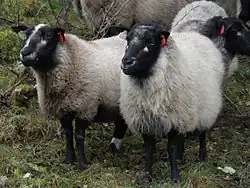Grey Troender
 | |
| Conservation status | |
|---|---|
| Other names |
|
| Country of origin | Norway |
| Standard | Norsk Sau og Geit (in Norwegian) |
| Traits | |
| Weight | |
| Wool colour | usually grey |
| |
The Grey Troender (Norwegian: Grå Trøndersau) is an endangered Norwegian breed of domestic sheep. It originated in – and is named for – the Trøndelag region of central Norway, and is thought to derive from cross-breeding in the late nineteenth century of local feral sheep of the area with stock of the now-extinct Tautra.
The sheep are usually grey, in varying shades, with black face and legs and a small distinctive white marking under each eye; other colours including black, brown and white are seen in about 20% of the population.[4]: 817 [5]
History
The Grey Troender originated in the Trøndelag region of central Norway, from which its name derives. It is thought to have resulted from cross-breeding in the late nineteenth century of local feral sheep of the area with stock of the now-extinct Tautra, from the island of Tautra in the kommune of Frosta in Trøndelag. It became identifiable as a distinct breed or type in the late nineteenth century[4]: 817 or from about 1930;[6] a full description was written by Fritz Loyt Johnsen in 1941.[6]
By the 1990s it considered to be extinct. In 1992 a surviving group was identified and rescued when already on its way to the slaughterhouse; this formed the basis of the first conservation flock.[6]
At the turn of the century there were approximately fifty of the sheep.[5] In 2025 a total population of 1959–9275 head was reported, including 1959 breeding ewes; the conservation status of the breed was listed in DAD-IS as "at risk/endangered-maintained".[2]
Characteristics
The Grey Troender is of medium size; ewes weigh from 50 to 80 kg, rams about 10 kg more.[3] The fleece is usually grey, varying in shade from light grey to almost black; other colours including black, brown and white are seen in about 20% of the population.[4]: 817 [5] The face is black, with a small distinctive tear-shaped white marking under each eye and sometimes with some white on the ridge of the nose; the legs are also black. The tail is of medium length.[3]
Use
The Grey Troender yields a fleece weighing some 2–3 kg greasy, with an average fibre diameter of 32.3 μm (equivalent to a Bradford count of 48s).[5]
When raised for meat, lambs are sent for slaughter after about six months, when they weigh some 30–40 kg.[5]
References
- ^ Barbara Rischkowsky, Dafydd Pilling (editors) (2007). List of breeds documented in the Global Databank for Animal Genetic Resources, annex to: The State of the World's Animal Genetic Resources for Food and Agriculture. Rome: Commission on Genetic Resources for Food and Agriculture, Food and Agriculture Organization of the United Nations. ISBN 9789251057629. Archived 23 June 2020.
- ^ a b Breed data sheet: Gra troendersau / Norway (Sheep). Domestic Animal Diversity Information System of the Food and Agriculture Organization of the United Nations. Accessed July 2025.
- ^ a b c d Regelverk for kåring av grå trøndersau 2024 (in Norwegian). Ås: Norsk Sau og Geit. Archived 14 July 2025.
- ^ a b c Valerie Porter, Lawrence Alderson, Stephen J.G. Hall, D. Phillip Sponenberg (2016). Mason's World Encyclopedia of Livestock Breeds and Breeding (sixth edition). Wallingford: CABI. ISBN 9781780647944.
- ^ a b c d e Norwegian Grey Troender sheep, (25). "NorthShed: Origin and diversity of North European sheep breeds". Agricultural Research Institute of Iceland. Archived 5 December 2020.
- ^ a b c Grå trøndersau (in Norwegian). Ås: Norwegian Institute of Bioeconomy Research. Archived 24 March 2025.